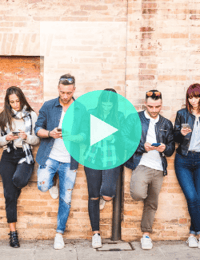
Mapping Out Your Instagram and Facebook Ad Funnel (Free Template)
March 27, 2019
If you’re not already running Facebook and/or Instagram ads for your business, there are probably six different people who have encouraged you to move some of your advertising dollars to paid social. But where should you start? And if you are advertising on Facebook and Instagram, are you following a sound strategy that mirrors successful inbound marketing principles?
Facebook and Instagram advertising is both an art and a science. You need to think like a scientist when it comes to testing, while using your creative brain to generate fresh ad copy and design. That’s what makes it interesting and challenging.
Back to Basics: What Inbound and Facebook Ads Have in Common
Paid social advertising can get overwhelming. Without a high-level strategy, it’s easy to get lost in the weeds. The best method is to take a step back and use the most basic inbound marketing principles to guide your strategy.
Inbound is all about providing value to your prospective customers. Facebook shows your ads to users based on how much value it predicts your ads will provide its users. With inbound, you would never want to send a bottom of the funnel sales email to someone who has never heard of your company before.
The same goes for Facebook and Instagram ads. When targeting “cold” audiences who don’t know who you are, you want to serve them useful content that helps solve their problems or reaches them on an emotional level.
Remember the inbound methodology:
1. Attract
2. Engage
3. Delight
It’s centered on building trust, credibility, and momentum. And that’s exactly what you want to do when launching and scaling your paid social ads. When it comes to paid social ads, our funnel looks pretty similar.
Mapping Out Your Funnel
The three key stages for taking a user who doesn't know about your business to someone who is ready to buy from you on paid social are:
1. Cold: Target users who have never heard of your organization before (example: Saved audiences based on demographics, interests, and so on).
2. Warm: Users who have liked your Facebook page, watched one of your videos, or engaged with you in some other way.
3. Hot: Users who are likely ready to make a purchase. Retargeting audiences are ideal at this stage. For example: Users who have added items to their cart on your website or visited key site pages.
Make sense? I put together this simple template to help you start mapping out the right audience and messaging at each stage of your paid social funnel: Paid Social Funnel Mapping Template.
A Note About Delight
The last stage isn’t on the template for simplicity’s sake, and that is the “delight” stage. For paid social, this might mean offering a VIP sale to your existing customers before you roll the discount code out to the masses. A campaign like this can be promoted effectively with Facebook and Instagram ads in conjunction with your email list. Initiatives like this can help you delight your existing customers.
Breaking Down the Barriers to Purchase
To make your funnel work, you need to be sure that your ads break down the common barriers to purchase that your prospective customers have. After you create an emotional appeal to users who don’t know your brand, it’s important to write strong copy and design ads that address what might prevent your personas from making a purchase.
Here are a few examples of what a user might think and the sort of ad copy you could use to address those thoughts. Let’s use a suitcase as the product being marketed:
“I can find something much cheaper.” → Tired of replacing your suitcase every other year? Same.
“What if this one breaks like the last one I bought?” → ✈ Unbreakable ✈ Guaranteed for life ✈ 90-day trial with free returns
“I don’t really need a new one of these.” → Meet the smartest travel companion you will ever have. ✅ Charge all of your devices ✅ TSA-approved combination lock ✅ Unbreakable shell ✅ Carry-on approved ✅ Extra lightweight
Take some time to write down all of the potential objections people have to purchasing your product or service, as well as how you can combat them.
Hint: Your sales team will come in clutch as you brainstorm these.
The platform is constantly evolving, and the strategies and tactics to generate successful results will change. That being said, basic marketing principles and methodologies will continue to form the backbone of those strategies and tactics.
Ready to test building out your own Facebook and Instagram ads funnel? Have questions about paid social or want to throw some ideas my way? Tweet at @smartbugmedia or reach out to me on Instagram.

About the author
Brooke Tomasetti was formerly a Marketing Consultant at SmartBug Media. She previously worked in digital marketing at a creative marketing and branding agency. Her goal can be pared down to using digital marketing to drive lead generation and revenue for clients. Brooke specializes in social media, generating ROI from paid social, marketing strategy, and maximizing her client's use of the HubSpot platform. Read more articles by Brooke Tomasetti.







